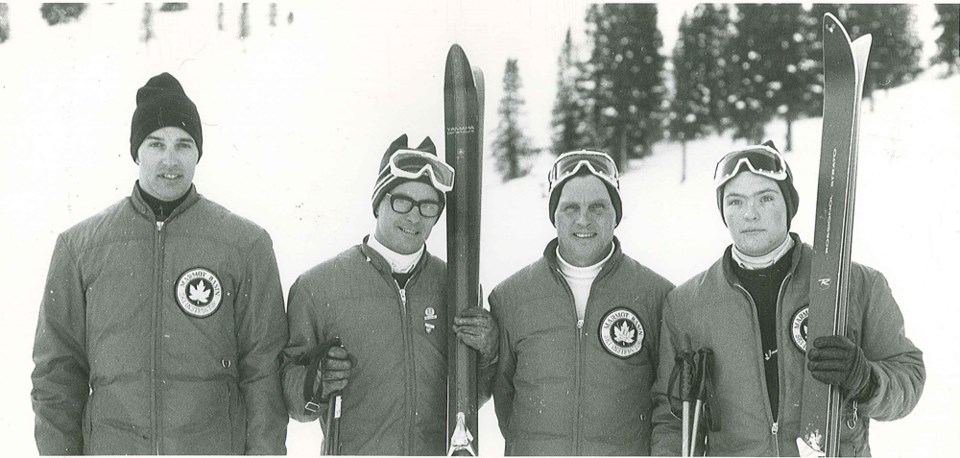
In its heyday, the ski school operating out of Marmot Basin had a reputation for producing some of the best skiers in the region. But even before Marmot opened to skiers in 1964, Jasperites were attending ski schools.
A 1962 issue of the Sunday Sun from Vancouver profiled the ski school at Whistlers Mountain, which taught kids from Jasper during the winter months.
Instruction started in Grade 4, and went right through to Grade 12. In 1962 130 kids attended, which was about half of all those eligible.
One of the instructors was Ray Parten, a service station worker who would start training kids early in the season by sending them along a homemade track around the perimeter of his yard.
“We don’t only want you to be skiers, but to look like skiers. Those who take up skiing haven’t time for slouching around the streets, and when Jasper skiers travel to meets, the school and town can be proud of them,” he said to his students as they trained.
In 1965, a year after Marmot opened, Joe Couture took a job at the ski school there, alongside Tom McCready. A few years later they became partners, and that partnership would form the foundation for the snow school still in operation at Marmot today.
Although in the early years the school was still a pretty small business, skiing’s popularity was set to take off, thanks in part to the swell of potential skiers provided by the baby boomer generation.
In the late 60s and early 70s, Couture said the sport was growing by as much as 15 per cent a year. While the baby boomers certainly helped that explosive growth, Couture said ski schools like the one he operated at Marmot played a huge part.
In the early days of skiing, Couture said ski hills weren’t especially interested in running ski schools, so the schools operated as private businesses, on contract with the hill operators.
That meant that all the people running the schools were people who were incredibly passionate about the sport.
“There was people that loved skiing, and they were the people in the ski schools,” Couture said.
They were passionate people, but passionate people who needed to make a living, so they promoted the sport aggressively.
“We had all these people we had to pay, and we had to make a living, so we went out and sold the sport,” Couture said.
Brian Rode is Marmot’s vice president of marketing and sales, but before he held that title he worked for Couture at the ski school. He explained that Couture was instrumental in building skiing’s popularity at Marmot, mostly through the ski weeks his school ran.
Ski weeks were week-long instruction programs Couture created after seeing them in action in eastern Canada. They brought people to the hill for a week of training and entertainment.
Along with top-notch ski instruction, every night the school offered its students movie nights, broomball games, wine and cheese parties or presentation nights.
“It was really cornbally, but it was fun,” Rode said.
What made the weeks so successful, however, was how aggressively Couture promoted them. Every year he would hit the road and tour across western Canada, promoting the ski weeks in major urban centres and small towns alike.
Couture still remembers the biggest ski week he ever held, attracting 1,284 people (a number he said he will always remember). He would cram hotels full of ski week participants, and scour western Canada for enough instructors to teach them.
He remembers going to parties in the hotels and discovering hundreds of people who wanted lessons, and staying up until 3 a.m. wrangling up enough instructors to teach them all.
In the mid 70s Couture’s partner McCready suffered a heart attack, and Couture bought the ski school outright. However, the sport’s growth was beginning to dip, and in the early 80s Marmot didn’t renew his contract, and took over the ski school.
Not long after the school changed hands, it stopped offering ski weeks.
“The paradigm has changed a little bit—people aren’t as interested in taking lessons five times a week—which is unfortunate because it was a lot of fun,” said Rode.
He remembered the older days at the ski school, where hundreds of students would gather at the top of the hill and instructors would split them into groups by waving them down the hill one at a time and assessing their technique.
Just like Couture packing five or six people into a hotel room, the idea was just to get as many people on the hill as possible.
“You’d just sell lessons. You’d sell as many as you could and pack as many as you could up there, you’d split them up into their classes and away you’d go,” Rode said.
Today, he explained, all the students at Marmot’s “snow school” are interviewed before they start, and the information is recorded into a giant spreadsheet that instructors use to split up the classes.
Rode admitted that people have different expectations from ski schools today—perfecting technique is less important than simply having fun going down the hill.
However, he said that even today, when a skier executes a perfect turn for the first time, he sees “the light bulb go off” and “their eyes light up.”
“That’s when they get hungry for more,” he said.
Trevor Nichols[email protected]
